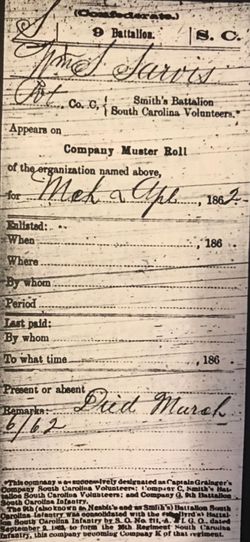William was a Confederate soldier who seems to have died at age 13 on March 6, 1862, two days before his 14th birthday. (His death date may have been either March 16 or March 26, 1862.) He served in the 9th South Carolina Infantry Battalion (the "Pee Dee Legion"), Company G. He volunteered in 1862, along with his father John Reynolds Sarvis and brother Thomas Lester Sarvis. (William died during the war in 1862.) The 9th was later merged with the 26th South Carolina Volunteers. The 26th saw action in South Carolina, Mississippi, and Virginia.
William is probably buried in an unmarked grave near his parents in Pleasant Meadow Baptist Church Cemetery in Horry County. Through his mother and father, William was of French Huguenot and English descent. Sarvis is a coastal Carolina Native American surname. In this case, however, the Sarvis surname may have originally been Serivens, a French Huegenot name.
An important point about American Indian (Native American) DNA ancestry should be made. Anthropologist Mary Helms created the term "colonial Indian tribes" in the 1960s to refer to societies which originated as recognizable entities only as a direct result of colonial policies. Colonial tribes are often a racially mixed people that over time became identified more with their Indian ancestry rather than their African or white ancestry. These groups are culturally Indian while ultimately having little, if any, Indian DNA. Colonial tribes include groups as diverse as the Miskito Indians of eastern Nicaragua, various Amazon tribes in Brazil, the Lumbee Indians of North Carolina, the Black Seminoles of Oklahoma, Mexico, and the Bahamas, and many others. The term colonial tribe attempts to get at the idea that someone can be culturally something (American Indian, for example) without being biologically something. So, it should not be surprising that someone with, for example, a Lumbee Indian ancestor would not necessarily test as having significant American Indian DNA.
I hope someone will add a photo of William. Thanks so much to Sarvis family researchers for much of this information. Any errors, however, are mine alone. Please go to the "edit" link on this site with any corrections or additions. If a closer relative than I would like to take over management of this site, please let me know.
William was a Confederate soldier who seems to have died at age 13 on March 6, 1862, two days before his 14th birthday. (His death date may have been either March 16 or March 26, 1862.) He served in the 9th South Carolina Infantry Battalion (the "Pee Dee Legion"), Company G. He volunteered in 1862, along with his father John Reynolds Sarvis and brother Thomas Lester Sarvis. (William died during the war in 1862.) The 9th was later merged with the 26th South Carolina Volunteers. The 26th saw action in South Carolina, Mississippi, and Virginia.
William is probably buried in an unmarked grave near his parents in Pleasant Meadow Baptist Church Cemetery in Horry County. Through his mother and father, William was of French Huguenot and English descent. Sarvis is a coastal Carolina Native American surname. In this case, however, the Sarvis surname may have originally been Serivens, a French Huegenot name.
An important point about American Indian (Native American) DNA ancestry should be made. Anthropologist Mary Helms created the term "colonial Indian tribes" in the 1960s to refer to societies which originated as recognizable entities only as a direct result of colonial policies. Colonial tribes are often a racially mixed people that over time became identified more with their Indian ancestry rather than their African or white ancestry. These groups are culturally Indian while ultimately having little, if any, Indian DNA. Colonial tribes include groups as diverse as the Miskito Indians of eastern Nicaragua, various Amazon tribes in Brazil, the Lumbee Indians of North Carolina, the Black Seminoles of Oklahoma, Mexico, and the Bahamas, and many others. The term colonial tribe attempts to get at the idea that someone can be culturally something (American Indian, for example) without being biologically something. So, it should not be surprising that someone with, for example, a Lumbee Indian ancestor would not necessarily test as having significant American Indian DNA.
I hope someone will add a photo of William. Thanks so much to Sarvis family researchers for much of this information. Any errors, however, are mine alone. Please go to the "edit" link on this site with any corrections or additions. If a closer relative than I would like to take over management of this site, please let me know.
Family Members
-
![]()
PVT Thomas Lester "Tommy" Sarvis
1847–1931
-
![]()
George Marsden Sarvis
1850–1871
-
![]()
Edward Charles "Ned" Sarvis
1851–1927
-
![]()
Helan Sarvis King
1852–1918
-
![]()
Sharlotte Ada Sarvis Neely
1853 – unknown
-
![]()
Rhoda Mary Elizabeth "Lizzie" Sarvis Cartrette
1854–1934
-
![]()
Eahmon A. Sarvis
1858–1871
-
![]()
Bowden Sarvis
1859–1871
-
![]()
Dock J Sarvis
1861–1931
-
![]()
James Scarborough Sarvis
1862–1919
Advertisement
Explore more
Sponsored by Ancestry
Advertisement














